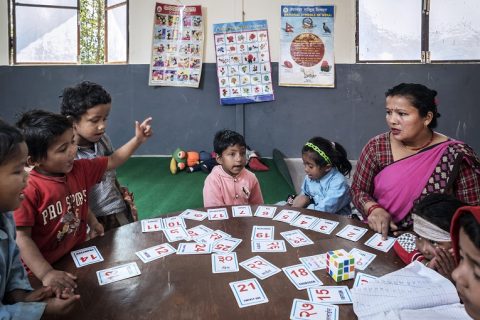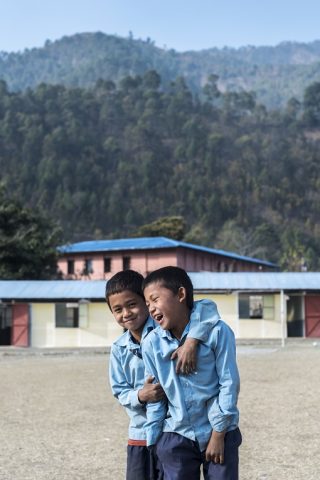Rebuilt schools are the pride of village communities – FCA constructs safe school buildings for 44,000
“I’m not worried about a new earthquake”, says 8-year-old Manjali Shah. “I know what to do.”
Two years ago, massive earthquakes in Nepal destroyed thousands of schools depriving one million children of a place of education. The almost one hundred-year-old school in Shah’s home village Bhimphed was severely damaged in the first earthquake at the end of April, and collapsed completely during an aftershock 17 days later.
Now, the Mahendar High School is operating normally, but instead of the old school building, teaching takes place in new barracks. Shah goes to fourth grade and uses fluent English to ask the Finnish visitors questions about their names and where they live.

3-4 year olds are learning numbers in English at Shree Bhrikuti Lower Secondary School, one of the schools which FCA has provided with safe school buildings.
“I want to become a teacher so I can share knowledge with others”, Shah says.
When the earthquake took place, Shah was home alone watching TV because her parents were out. She got out unharmed, but the house was heavily damaged. Shah and her family had no choice but to live outside for a month before they were able to return home.
School activities didn’t resume for six weeks after the earthquake. At first, many children didn’t show up for school, says Headmaster Ramji Yadav. Some didn’t know that school activities had resumed. Some feared aftershocks too much to come.
At first, regular teaching was set aside and instead everything in school was based on games and play.
“This was a way of encouraging children to come back to school. We had different fun activities and we didn’t give the children any homework. We also gave the children instructions on what to do during an earthquake.”
Children who attended classes told other children what they had learned about earthquake preparation. This built trust among the other children and three months after the earthquake most of the children were back in school.
334 concrete school buildings
First, temporary classrooms were constructed from bamboo and chicken wire. Then, construction began on semi-permanent structures with concrete walls. School staff is extremely happy with these new buildings.

The open field in from of the Mahendar High School is a children’s play field. It will be used as a gathering place in case of a new earthquake.
“We now have a place where the children can come to learn”, Yadav says with pride.
A single building has two classrooms, both of which can hold up to 40 pupils. Small children under 6 years old study around a low standing table, sitting on the floor. The bigger kids study sitting at desks.
The buildings are intended for temporary use for 15 to 20 years. The school in Bhimphed was the first one to have this particular type of semi-permanent school structures.
In total, Finn Church Aid constructs 334 similar semi-permanent school buildings to replace schools collapsed in the earthquakes. This makes FCA the second biggest international organization in Nepal to reconstruct earthquake damaged schools.
The schools now also have water and sanitation facilities like toilets and hand-washing stations. FCA staff has instructed locals on the maintenance of these sanitation facilities and the importance of personal hygiene.
School buildings create a sense of security
Shree Bhrikuti Lower Secondary School is located on a hillside on the outskirts of Thati Pokhari village. As you make the climb up the hill towards the school, around halfway up you hear sounds of rhythmic and upbeat recitation. One class is studying colours in English, and another is going through multiplication tables.
All construction materials for the new structures had to be carried up the hill by hand because there is no road leading up to the school. Before construction was finished, teaching was organised outside on a plaza which, on sunny days, becomes scorching hot. The plaza is where the old school building stood before it collapsed in the earthquake.
Headmaster Tara Jashi says the pupils are relieved to have safe school structures to study in. Teachers at the school have received training on how to prepare for natural disasters. After a couple days of training they are now planning small changes to the school facilities. They are clearly excited to be able to make the school an even safer environment for the children.
The school is important for the entire village community, and the school board has arrived in its entirety to welcome the Finnish visitors.
“By educating children we are helping them reach a good, comfortable and peaceful life”, Jashi says to emphasize the importance of education.
Text: Maija Lappalainen
Photos: Johanna Erjonsalo
FCA Humanitarian Aid and School Construction
28,878 people received Food and Non Food Items
2,000 Emergency Shelters
5 Child friendly spaces
170 Temporary Learning Spaces
334 Semi-permanentSchools
=Safe Learning Spaces for 44,000
556 Semi-permanent Latrines with Hand-washing Facilities
2,880 Educational and Recreational kits
1,750 receive Teacher Training in school-based Disaster Preparedness, Child-centered teaching
12,000 individuals were trained in Psychosocial Support
https://youtu.be/nIGaFVBvgoY